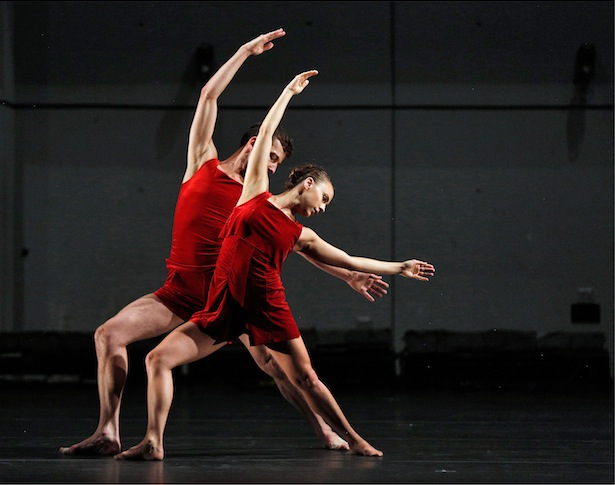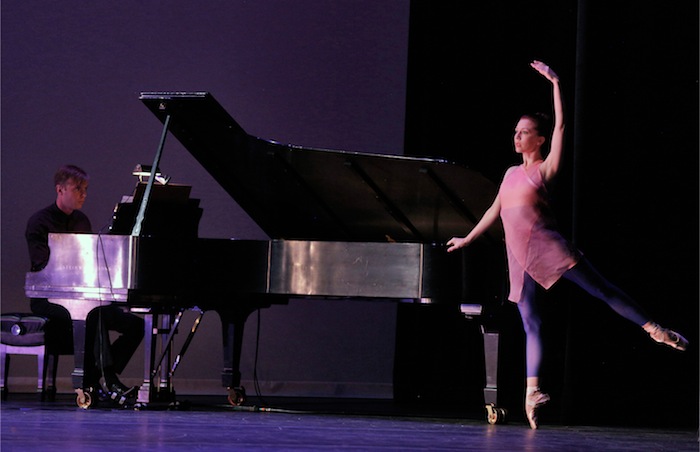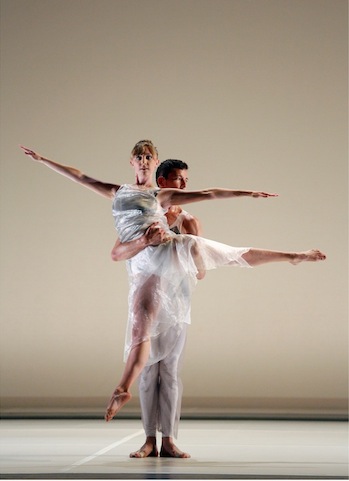Dance Review: Pam Tanowitz — Dancing the Phrase
Pam Tanowitz’s performance at Bard College seemed to be as much about the connections among artists and their ideas as about the unanticipated gaps between them.
Pam Tanowitz Dance and FLUX Quartet, Fisher Center at Bard College SummerScape 2015, Annandale-on-Hudson, N.Y., June 27 and 28.

Dylan Crossman and Sarah Haarmann performing in “Heaven on One’s Head,” Pam Tanowitz Dance. Photo: Cory Weaver.
By Marcia B. Siegel
Pam Tanowitz makes musical dances. She doesn’t try to duplicate the music precisely, or plot movement to illustrate sounds. Instead, she seems to hear musical phrases as physical actions, and then to orchestrate danced echoes and interjections into the music. This is unusual and refreshing in an age when music is mostly used as atmosphere, shock, or ironic adversary by dancers — or disregarded entirely. Her performance at Bard College seemed to be as much about the connections among artists and their ideas as about the unanticipated gaps between them.
Merce Cunningham wanted the artistic elements to be independent of each other. His composers usually didn’t see a dance before completing the score. Cunningham often used indeterminate scores that didn’t have precise cues the dancers could depend on, or there’d be unpredictable parts that the dancers would hear for the first time in performance. Even the accompanists for his dance classes might be playing something different in timing or dynamics from the combination he’d given the dancers. Succeeding generations of modern and contemporary ballet choreographers have followed him into musical disengagement.
Pam Tanowitz studied with one of Cunningham’s early stars, Viola Farber, at Sarah Lawrence College. The dances at Bard Saturday night didn’t look like either Cunningham’s or Farber’s dances, but they evoked both those mentors in their oddness, their concentratedness and imperturbability. Tanowitz’s work reminded me of the way I used to feel looking at the Cunningham company after a long absence. Here was this tribe of individuals who moved in really strange ways and seemingly didn’t pay attention to each other though they could move together when necessary, like schools of fish. But then I’d get used to them and admire their beauty.

Michael Scales and Ashley Tuttle in “Untitled (solo for Ashley Tuttle),” Pam Tanowitz Dance. Photo: Cory Weaver.
Saturday night’s program opened with Broken Story (wherein there is no ecstasy) (Tanowitz is fond of long titles), set to post-minimalist pieces for string quartet by Caroline Shaw, David Lang, and Ted Hearne. Dylan Crossman begins the dance in a long solo of short statements and stillnesses. Maggie Cloud joins him, or rather, she appears and dances her own solo. Their movement is very exacting, with stretched legs and active arms, and access to all directions through a mobile torso and head. They don’t seem to repeat anything. Soon I notice that both of them emphasize where they focus their gaze. Cloud exits and reappears to cross behind a scrim while Crossman continues dancing. When Cloud re-enters, they confront each other with soft heel steps and quiet, broken-off supporting movements.
A second woman (Melissa Toogood) joins them, and the two females circle Crossman, who ignores them. Toogood sweeps around the stage in an extraordinary, quiet solo of extended legs, turns, and reversals of direction, all high on her toes. She seems undisturbed until a man (Stuart Singer) stands behind her in the same position. He leaves her more agitated. Her body contracts, sending her into twisty changes of direction, wide pliés and lunges with her upper body curved over.
These maneuvers expand and overlap for what seems like a long time, growing more intense. There are more stillnesses and disappearances, and more ghostly goings-on behind the scrim. The couples dance together, only infrequently yielding to their partners in lifts or supported turns. Toogood runs and jumps at Singer, who catches her in midair with her legs stretched into a suspended leap. After he leaves she spins across the stage and glides quickly backward toward the wings. Singer is waiting there to catch her before she crashes into anything, and the music ends.
Tanowitz has indicated that one of her sources for Broken Story was a J.D. Salinger story about incomplete romantic relationships. There’s much in the dance to confirm this — couples that either don’t connect or that make only glancing contact. But the movement was so absorbing to me that the implications of personal stories seemed almost intrusive. I didn’t want it to end.
Solo, for Ashley Tuttle, was set to Carlos Chávez’s “Sonatina for Violin and Piano” (played by onstage pianist Michael Scales and violinist Pauline Kim Harris). Tuttle was a principal dancer for American Ballet Theater and created the “ballerina” role of Judy in Twyla Tharp’s long-running show Movin’ Out.
Tanowitz, a modern dancer, has made works for several ballet companies, but she hadn’t explored the use of the pointe shoe. In Solo she tames the sometimes jarring sound of the blocked pointe shoe and makes it part of her phrase rhythms. To the brief Chávez score, Tuttle whizzed through classical arm gestures and speedy pointe work, with sudden stops, derangements, and poses.

Maggie Cloud and Dylan Crossman performing in “Broken Story (wherein there is no ecstasy),” Pam Tanowitz Dance. Photo: Cory Weaver.
During intermission, Lindsey Jones, unannounced and uncredited, performed a phenomenal lobby solo, dancing back and forth between two of the massive concrete pillars that hold up Frank Gehry’s building. Jones didn’t repeat anything, and she didn’t allow the surrounding audience to distract her. She reminded me of the purposeful but seemingly irrelevant dance interludes that used to crop up in crowds during the freewheeling days of the 1960s and ’70s.
Heaven on One’s Head was set to Conlon Nancarrow’s String Quartets No. 1 and 3. Six of Nancarrow’s “Rhythmic Studies” accompanied Merce Cunningham’s eccentric early work Crises, with an equally eccentric Viola Farber, who was in Cunningham’s company at the time. The enigmatic Nancarrow spent much of his life in Mexico, composing for player-piano in lieu of opportunities to have his music performed in concert. These manic, repetitive rhythm pieces go so fast no live musician can play them. The quartets that Tanowitz used for Heaven on One’s Head are made of complicated rhythms, as well as coloristic sounds and stirring effects, totally unlike the mechanical Nancarrow I’ve heard on many dance stages since the ’60s.
Heaven began with two dancers noodling in front of the stage while stagehands moved the piano. The FLUX musicians resumed their place in the other corner and after a duet by Toogood and Crossman, other dancers fell onto the stage from the wings and were invisibly dragged out again. Later on, Toogood danced a long solo on the apron with the curtain lowered to about three feet from the floor. Parts of the other dancers were visible beneath it. I took this as a reference to George Balanchine’s early escapade with the Diaghilev Ballets Russes: In 1926, uncredited, he provided the Entr’acte for Bronislava Nijinska’s avant-garde Romeo and Juliet, with the curtain raised just enough to reveal the dancers’ feet.
In Heaven on One’s Head the eight dancers went through playful patterns, balletic posing, and partnering, twirling turns. They wore red velour tops and shorts, identical except that the women’s had red fringe under the bust. (Costumes for this and the other two dances were by Reid Bartelme.) In the end they were leaping off into the wings, disappearing with the music.
Internationally known writer, lecturer, and teacher Marcia B. Siegel covered dance for 16 years at the Boston Phoenix. She is a Contributing Editor for the Hudson Review. The fourth collection of Siegel’s reviews and essays, Mirrors and Scrims–The Life and Afterlife of Ballet, won the 2010 Selma Jeanne Cohen prize from the American Society for Aesthetics. Her other books include studies of Twyla Tharp, Doris Humphrey, and American choreography. From 1983-1996 Siegel was a member of the resident faculty of the Department of Performance Studies, Tisch School of the Arts, New York University.
